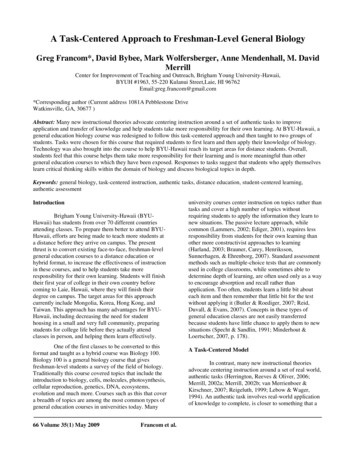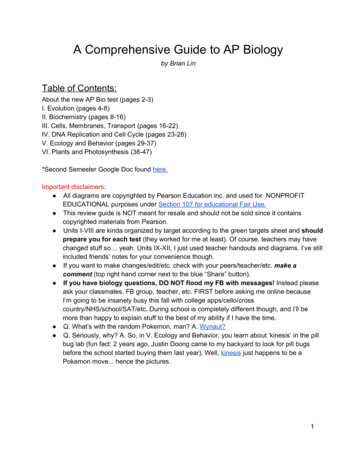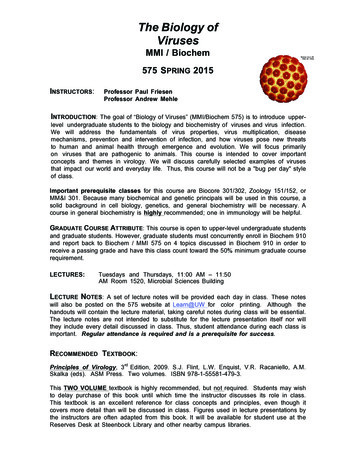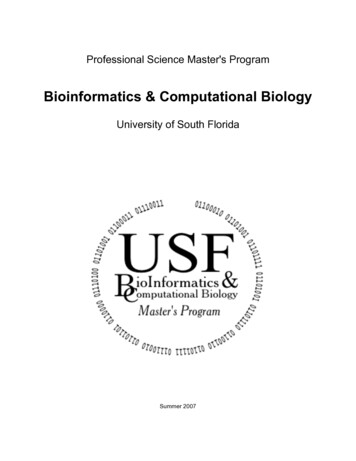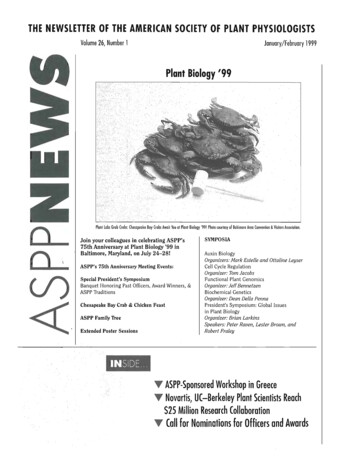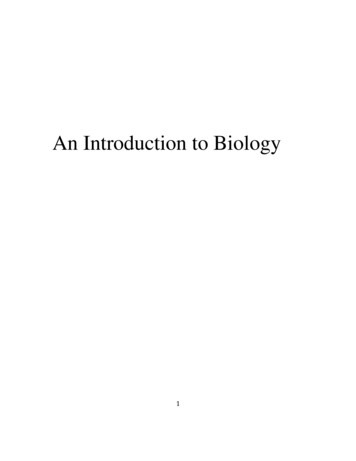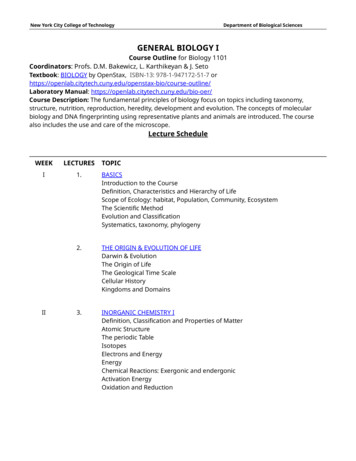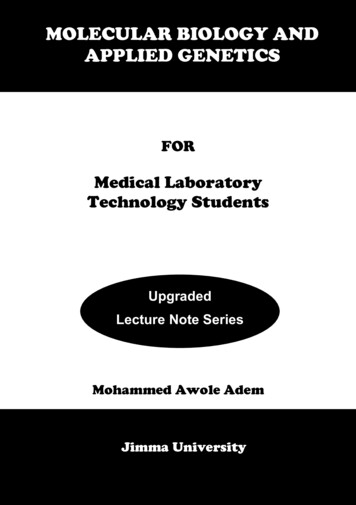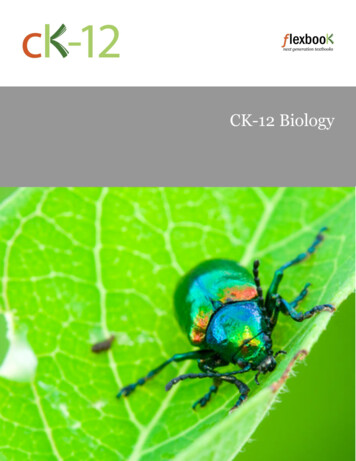
Transcription
AP Biology Summer 18Jean Brainard, Ph.D.Say Thanks to the AuthorsClick http://www.ck12.org/saythanks(No sign in required)
www.ck12.orgTo access a customizable version of this book, as well as otherinteractive content, visit www.ck12.orgCK-12 Foundation is a non-profit organization with a mission toreduce the cost of textbook materials for the K-12 market both inthe U.S. and worldwide. Using an open-source, collaborative, andweb-based compilation model, CK-12 pioneers and promotes thecreation and distribution of high-quality, adaptive online textbooksthat can be mixed, modified and printed (i.e., the FlexBook textbooks).AUTHORJean Brainard, Ph.D.EDITORDouglas Wilkin, Ph.D.CONTRIBUTORSBarbara Akre, M.A.Jennifer Blanchette, Ph.D.Niamh Gray-WilsonCopyright 2018 CK-12 Foundation, www.ck12.orgThe names “CK-12” and “CK12” and associated logos and theterms “FlexBook ” and “FlexBook Platform ” (collectively“CK-12 Marks”) are trademarks and service marks of CK-12Foundation and are protected by federal, state, and internationallaws.Any form of reproduction of this book in any format or medium,in whole or in sections must include the referral attribution linkhttp://www.ck12.org/saythanks (placed in a visible location) inaddition to the following terms.Except as otherwise noted, all CK-12 Content (including CK-12Curriculum Material) is made available to Users in accordancewith the Creative Commons Attribution-Non-Commercial 3.0Unported (CC BY-NC 3.0) License (http://creativecommons.org/licenses/by-nc/3.0/), as amended and updated by Creative Commons from time to time (the “CC License”), which is incorporatedherein by this reference.Complete terms can be found at http://www.ck12.org/about/terms-of-use.Printed: May 21, 2018iii
Contentswww.ck12.orgContents1What is Biology?1.1Science and the Natural World . . . . . . . . . . . . . . . . . . . . . . . . . . . . . . . . . . .1.2Biology: The Study of Life . . . . . . . . . . . . . . . . . . . . . . . . . . . . . . . . . . . . .1.3References . . . . . . . . . . . . . . . . . . . . . . . . . . . . . . . . . . . . . . . . . . . . . .1211222Science and the Natural World233Biology: The Study of Life284The Chemistry of Life4.1Matter and Organic Compounds4.2Biochemical Reactions . . . . .4.3Water, Acids, and Bases . . . . .4.4References . . . . . . . . . . . .34354753605Matter and Organic Compounds616Biochemical Reactions677Water, Acids, and Bases738Cellular Structure and Function8.1Introduction to Cells . . . . . . .8.2Cell Structures . . . . . . . . . .8.3Cell Transport and Homeostasis .8.4References . . . . . . . . . . . .9.Introduction to Cells80819010010810910 Cell Structures11511 Cell Transport and Homeostasis12112 Biology Glossary12.1A. . . . .12.2B . . . . .12.3C . . . . .12.4D. . . . .12.5E . . . . .12.6F . . . . .12.7G. . . . .12.8H. . . . .12.9I . . . . .127128133136142144148150154156iv.
1712.1812.1912.2012.2112.2212.2312.24J .K.L .MN.O.P .R .S .T .U.V.WX.Z 90191v
www.ck12.orgChapter 1. What is Biology?C HAPTER1What is Biology?Chapter Outline1.1S CIENCE AND THE N ATURAL W ORLD1.2B IOLOGY: T HE S TUDY OF L IFE1.3R EFERENCESIs this picture a colorful work of abstract art, or is it something else? Imagine shrinking down to a tiny size, so smallyou could enter a blood vessel. This illustration shows what you might see rushing toward you. Do you know whatthe red objects are? If you guessed red blood cells, you are right. What about the knobby green objects? Watch outfor these! They are viruses that have invaded the blood. However, this image is not scale, in reality viruses are muchsmaller in relationship to the red blood cells pictured here.When you read this book, you will take an exciting journey into the realm of blood cells, viruses, and just abouteverything else that is related to life. You will learn how your own body works, what makes living things unique,and what you and viruses have in common. This first chapter explains how scientists learn about the natural worldand introduces you to biology, the science of life.Image copyright K j pargeter, 2014. www.shutterstock.com. Used under license f rom Shutterstock.com.1
1.1. Science and the Natural Worldwww.ck12.org1.1 Science and the Natural WorldLesson Objectives Identify the goal of science.Describe how scientists study the natural world.Explain how and why scientists do experiments.Describe types of scientific investigations.Explain what a scientific theory is.Vocabulary dependent variableevidenceexperimenthypothesisindependent c investigationscientific lawscientific methodscientific theoryIntroductionDid you ever wonder why giraffes have such long necks or how birds learn to sing their special songs? If you everasked questions such as these about the natural world, then you were thinking like a scientist. The word sciencecomes from a Latin word that means “knowledge.” Science is a distinctive way of gaining knowledge about thenatural world that starts with a question and then tries to answer the question with evidence and logic. Science is anexciting exploration of all the whys and hows that any curious person might have about the world. You can be partof that exploration. Besides your curiosity, all you need is a basic understanding of how scientists think and howscience is done, starting with the goal of science.2
www.ck12.orgChapter 1. What is Biology?The Goal of ScienceThe goal of science is to understand the natural world. To achieve this goal, scientists make certain assumptions.They assume that: Nature can be understood through systematic study.Scientific ideas are open to revision.Sound scientific ideas withstand the test of time.Science cannot provide answers to all questions.Nature Can Be UnderstoodScientists think of nature as a single system controlled by natural laws. By discovering natural laws, scientists striveto increase their understanding of the natural world. Laws of nature are expressed as scientific laws. A scientificlaw is a statement that describes what always happens under certain conditions in nature.An example of a scientific law is the law of gravity, which was discovered by Sir Isaac Newton (see Figure 1.1). Thelaw of gravity states that objects always fall towards Earth because of the pull of gravity. Based on this law, Newtoncould explain many natural events. He could explain not only why objects such as apples always fall to the ground,but he could also explain why the moon orbits Earth. Isaac Newton discovered laws of motion as well as the law ofgravity. His laws of motion allowed him to explain why objects move as they do.FIGURE 1.1Did Newton discover the law of gravity when an apple fell from a tree andhit him on the head? Probably not, but observations of nature are oftenthe starting point for new ideas about the natural world.Scientific Ideas Can ChangeScience is more of a process than a set body of knowledge. Scientists are always testing and revising their ideas,and as new observations are made, existing ideas may be challenged. Ideas may be replaced with new ideas thatbetter fit the facts, but more often existing ideas are simply revised. For example, when Albert Einstein developedhis theory of relativity, he didn’t throw out Newton’s laws of motion. Instead, he showed that Newton’s laws are apart of a bigger picture. In this way, scientists gradually build an increasingly accurate and detailed understandingof the natural world.Scientific Knowledge Can Withstand the Test of TimeMany scientific ideas have withstood the test of time. For example, about 200 years ago, the scientist John Daltonproposed atomic theory—the theory that all matter is made of tiny particles called atoms. This theory is still valid3
1.1. Science and the Natural Worldwww.ck12.orgtoday. There are many other examples of basic science ideas that have been tested repeatedly and found to be true.You will learn about many of them as you study biology.Science Cannot Answer All QuestionsScience rests on evidence and logic, so it deals only with things that can be observed. An observation is anythingthat is detected either through human senses or with instruments and measuring devices that extend human senses.Things that cannot be observed or measured by current means—such as supernatural beings or events—are outsidethe bounds of science. Consider these two questions about life on Earth: Did life on Earth evolve over time? Was life on Earth created through another method?The first question can be answered by science on the basis of scientific evidence and logic. The second questioncould be a matter of belief. Therefore, it is outside the realm of science.Why I Do ScienceDan Costa, Ph.D. is a professor of Biology at the University of California, Santa Cruz, and has been studying marinelife for well over 40 years. He is a leader in using satellite tags, time and depth recorders and other sophisticatedelectronic tags to gather information about the amazing depths to which elephant seals dive, their migration routesand how they use oceanographic features to hunt for prey as far as the international dateline and the Alaskan AleutianIslands. In the following KQED video, Dr. Costa discusses why he is a scientist:MEDIAClick image to the left or use the URL below.URL: 84The Scientific Method“We also discovered that science is cool and fun because you get to do stuff that no one has ever done before.” Inthe article Blackawton bees, published by eight to ten year old students: Biology Letters (2010) ly/2010/12/18/rsbl.2010.1056.abstract .There are basic methods of gaining knowledge that are common to all of science. At the heart of science is thescientific investigation, which is done by following the scientific method. A scientific investigation is a plan forasking questions and testing possible answers. It generally follows the steps listed in Figure 1.2. See http://www.youtube.com/watch?v KZaCy5Z87FA for an overview of the scientific method.4
www.ck12.orgChapter 1. What is Biology?FIGURE 1.2Steps of a Scientific Investigation. A scientific investigation typically hasthese steps.Making ObservationsA scientific investigation typically begins with observations. You make observations all the time. Let’s say you takea walk in the woods and observe a moth, like the one in Figure 1.3, resting on a tree trunk. You notice that the mothhas spots on its wings that look like eyes. You think the eye spots make the moth look like the face of an owl.FIGURE 1.3Does this moth remind you of an owl?Asking a QuestionObservations often lead to questions. For example, you might ask yourself why the moth has eye spots that make itlook like an owl’s face. What reason might there be for this observation?Forming a HypothesisThe next step in a scientific investigation is forming a hypothesis. A hypothesis is a possible answer to a scientificquestion, but it isn’t just any answer. A hypothesis must be based on scientific knowledge, and it must be logical. Ahypothesis also must be falsifiable. In other words, it must be possible to make observations that would disprove thehypothesis if it really is false. Assume you know that some birds eat moths and that owls prey on other birds. Fromthis knowledge, you reason that eye spots scare away birds that might eat the moth. This is your hypothesis.5
1.1. Science and the Natural Worldwww.ck12.orgTesting the HypothesisTo test a hypothesis, you first need to make a prediction based on the hypothesis. A prediction is a statement thattells what will happen under certain conditions. It can be expressed in the form: If A occurs, then B will happen.Based on your hypothesis, you might make this prediction: If a moth has eye spots on its wings, then birds will avoideating it.Next, you must gather evidence to test your prediction. Evidence is any type of data that may either agree or disagreewith a prediction, so it may either support or disprove a hypothesis. Assume that you gather evidence by makingmore observations of moths with eye spots. Perhaps you observe that birds really do avoid eating the moths. Thisevidence agrees with your prediction.Drawing ConclusionsEvidence that agrees with your prediction supports your hypothesis. Does such evidence prove that your hypothesisis true? No; a hypothesis cannot be proven conclusively to be true. This is because you can never examine all ofthe possible evidence, and someday evidence might be found that disproves the hypothesis. Nonetheless, the moreevidence that supports a hypothesis, the more likely the hypothesis is to be true.Communicating ResultsThe last step in a scientific investigation is communicating what you have learned with others. This is a veryimportant step because it allows others to test your hypothesis. If other researchers get the same results as yours,they add support to the hypothesis. However, if they get different results, they may disprove the hypothesis.When scientists share their results, they should describe their methods and point out any possible problems withthe investigation. For example, while you were observing moths, perhaps your presence scared birds away. Thisintroduces an error into your investigation. You got the results you predicted (the birds avoided the moths while youwere observing them), but not for the reason you hypothesized. Other researchers might be able to think of ways toavoid this error in future studies.ExperimentsFigure 1.4 shows a laboratory experiment involving plants. An experiment is a special type of scientific investigation that is performed under controlled conditions, usually in a laboratory. Some experiments can be very simple,but even the simplest contributed important evidence that helped scientists better understand the natural world. Anexample experiment can be seen here http://www.youtube.com/watch?v dVRBDRAsP6U or here http://www.youtube.com/watch?v F10EyGwd57M .FIGURE 1.4A laboratory experiment studying plant growth. What might this experiment involve?6
www.ck12.orgChapter 1. What is Biology?VariablesAn experiment generally tests how one variable is affected by another. The affected variable is called the dependentvariable. In the plant experiment shown in the Figure 1.4, the dependent variable is plant growth. The variable thataffects the dependent variable is called the independent variable. In the plant experiment, the independent variableis fertilizer—some plants will get fertilizer, others will not. In any experiment, other factors that might affect thedependent variable must be controlled. In the plant experiment, what factors do you think should be controlled?(Hint: What other factors might affect plant growth?)Sample Size and RepetitionThe sample in an experiment or other investigation consists of the individuals or events that are studied. Typically,the sample is much smaller than all such individuals or events that exist in the world. Whether the results based onthe sample are true in general cannot be known for certain. However, the larger the sample is, the more likely itis that the results are generally true. Similarly, the more times that an experiment is repeated and the same resultsobtained, the more likely the results are valid. This is why scientific experiments should always be repeated.Other Types of Scientific InvestigationsExperiments are sometimes hard or even impossible to do. For example, a scientist who is studying an extinct animalcannot experiment with the animal because it no longer exists. The scientist must rely instead on evidence in thenatural world, such as fossils that the extinct animal left behind.Natural StudiesWhen scientists do studies in nature, they usually cannot control factors that might affect the variables they areinvestigating. This is a drawback, because it may make the observations difficult to interpret. Without controls, itmay not be possible to determine which of many factors explain the observations. For example, assume you arestudying how plants grow in a forest or field. You cannot control the amount of sunlight or rain water the plantsreceive, so it will be difficult to determine which factors most influence plant growth. On the other hand, a naturalstudy shows what actually occurs in nature. Therefore, it may provide a truer picture of what happens in the realworld than an experiment does.ModelingAnother way to gain scientific knowledge without experiments is by making and manipulating models. A model is arepresentation of part of the real world. Did you ever build a model car? Scientific models are something like modelcars; they represent the real world but are simpler than the real world. This is one reason that models are especiallyuseful for investigating complex systems. By using a model, scientists can better understand how the real systemworks. An example of a scientific model is shown in Figure 1.5. Do you know what systems these two modelsrepresent?Like a hypothesis, a model must be evaluated. It is assessed by criteria such as how well it represents the real world,what limitations it has, and how useful it is. The usefulness of a model depends on how well its predictions match7
1.1. Science and the Natural Worldwww.ck12.orgFIGURE 1.5Food Chains. These two food chains represent complex systems in nature. Theymake the systems easier to understand.These are simple conceptual models.Models of very complex systems are often based on mathematical equations orcomputer simulations.observations of the real world. Even when a model’s predictions match real-world observations, however, it doesn’tprove that the model is true or that it is the only model that works.Scientific TheoriesWith repeated testing, some hypotheses may eventually become scientific theories. A scientific theory is a broadexplanation for events that is widely accepted as true. To become a theory, a hypothesis must be tested over and overagain, and it must be supported by a great deal of evidence.People commonly use the word theory to describe a guess about how or why something happens. For example, youmight say, “I think a woodchuck dug this hole in the ground, but it’s just a theory.” Using the word theory in thisway is different from the way it is used in science. A scientific theory is more like a fact than a guess because it isso well-supported. There are several well-known theories in biology, including the theory of evolution, cell theory,8
www.ck12.orgChapter 1. What is Biology?and germ theory. You will read about all three of these theories in the next lesson “Biology: The Study of Life.” Avideo explaining scientific theories can be seen at http://www.youtube.com/watch?v S5YGhprR6KE .KQED: Bio-Inspiration: Nature as MuseFor hundreds of years, scientists have been using design ideas from structures in nature. Now, biologists andengineers at the University of California, Berkeley are working together to design a broad range of new products,such as life-saving milli-robots modeled on the way cockroaches run and adhesives based on the amazing design ofa gecko’s foot. This process starts with making observations of nature, which lead to asking questions and to theadditional aspects of the scientific process. Bio-Inspiration: Nature as Muse can be observed at :MEDIAClick image to the left or use the URL below.URL: esson Summary The goal of science is to understand the natural world through systematic study. Scientific knowledge is basedon evidence and logic. Scientists gain knowledge through scientific investigations. A scientific investigation is a plan for askingquestions and testing possible answers. Scientists use experiments to test hypotheses under controlled conditions. Experiments are often done in a lab. Other types of scientific investigations include natural studies and modeling. They can be used when experiments are difficult to do. Scientific theories are broad explanations that are widely accepted as true. This is because they are supportedby a great deal of evidence.Lesson Review QuestionsRecall1. What is science? What is the goal of science?2. Outline the steps of a scientific investigation.3. What is a scientific hypothesis? What characteristics must a hypothesis have to be useful in science?4. Give an example of a scientific question that could be investigated with an experiment. Then give an example ofscientific question that could not be investigated in this way.5. What might be an advantage of collecting evidence in a natural setting rather than in a lab?9
1.1. Science and the Natural Worldwww.ck12.orgApply Concepts6. Identify the independent and dependent variables in the following experiment:A scientist grew bacteria on gel in her lab. She wanted to find out if the bacteria would grow faster on gel A or gelB. She placed a few bacteria on gel A and a few on gel B. After 24 hours, she observed how many bacteria werepresent on each type of gel.Think Critically7. Explain why science cannot provide answers to all questions.8. Contrast how the term theory is used in science and in everyday language.9. Explain how a hypothesis could become a theory.Points to ConsiderThe Points to Consider at the end of each lesson in this book will help you relate what you just learned to what iscoming next. The questions will help guide you to the next lesson or chapter. Before reading the next lesson of thischapter, consider these points: Remember the opening photo of red blood cells and green viruses? The blood cells are cells of a living thing.Do you think that the viruses are living things? Why or why not? Lab experiments are the main method of gathering evidence in some branches of science. Why might labexperiments not be the best way to study living things, such as wild animals?10
www.ck12.orgChapter 1. What is Biology?1.2 Biology: The Study of LifeLesson Objectives List the characteristics of all living things.State four unifying principles of biology.Describe how living things interact.Explain how life on Earth evolves.Vocabulary l theorycommunitycompetitionecosystemevolutiongene theoryhomeostasisnatural selectionorganorgan eIntroductionIn this book, you will learn about one particular branch of science, the branch called biology. Biology is the scienceof life. Do you know what life is? Can you define it? Watch http://vimeo.com/15407847 to begin your journey intothe study of life.11
1.2. Biology: The Study of Lifewww.ck12.orgCharacteristics of LifeLook at the duck decoy in Figure 1.6. It looks very similar to a real duck. Of course, real ducks are living things.What about the decoy duck? It looks like a duck, but it is actually made of wood. The decoy duck doesn’t have allthe characteristics of a living thing. What characteristics set the real ducks apart from the decoy duck? What are thecharacteristics of living things?FIGURE 1.6This duck decoy looks like it’s alive. It even fools real ducks. Why isn’t it aliving thing?To be classified as a living thing, an object must have all six of the following characteristics:1.2.3.4.5.6.It responds to the environment.It grows and develops.It produces offspring.It maintains homeostasis.It has complex chemistry.It consists of cells.Response to the EnvironmentAll living things detect changes in their environment and respond to them. What happens if you step on a rock?Nothing; the rock doesn’t respond because it isn’t alive. But what if you think you are stepping on a rock andactually step on a turtle shell? The turtle is likely to respond by moving—it may even snap at you!Growth and DevelopmentAll living things grow and develop. For example, a plant seed may look like a lifeless pebble, but under the rightconditions it will grow and develop into a plant. Animals also grow and develop. Look at the animals in Figure 1.7.How will the tadpoles change as they grow and develop into adult frogs?ReproductionAll living things are capable of reproduction. Reproduction is the process by which living things give rise tooffspring. Reproducing may be as simple as a single cell dividing to form two daughter cells. Generally, however,it is much more complicated. Nonetheless, whether a living thing is a huge whale or a microscopic bacterium, it iscapable of reproduction.12
www.ck12.orgChapter 1. What is Biology?FIGURE 1.7Tadpoles go through many changes tobecome adult frogs.Keeping Things ConstantAll living things are able to maintain a more-or-less constant internal environment. They keep things relatively stableon the inside regardless of the conditions around them. The process of maintaining a stable internal environmentis called homeostasis. Human beings, for example, maintain a stable internal body temperature. If you go outsidewhen the air temperature is below freezing, your body doesn’t freeze. Instead, by shivering and other means, itmaintains a stable internal temperature.Complex ChemistryAll living things—even the simplest life forms—have complex chemistry. Living things consist of large, complexmolecules, and they also undergo many complicated chemical changes to stay alive. Complex chemistry is neededto carry out all the functions of life.CellsAll forms of life are built of cells. A cell is the basic unit of the structure and function of living things. Living thingsmay appear very different from one another on the outside, but their cells are very similar. Compare the human cellsand onion cells in Figure 1.8. How are they similar? If you click on the animation titled Inside a Cell at the linkbelow, you can look inside a cell and see its internal structures. ifying Principles of BiologyFour unifying principles form the basis of biology. Whether biologists are interested in ancient life, the life ofbacteria, or how humans could live on the moon, they base their overall understanding of biology on these fourprinciples:1. cell theory13
1.2. Biology: The Study of Lifewww.ck12.orgFIGURE 1.8A representation of human cells (left) and onion cells (right). If you looked at human and onion cells under amicroscope, this is what you might see.2. gene theory3. homeostasis4. evolutionThe Cell TheoryAccording to the cell theory, all living things are made up of cells, and living cells always come from other livingcells. In fact, each living thing begins life as a single cell. Some living things, such as bacteria, remain single-celled.Other living things, including plants and animals, grow and develop into many cells. Your own body is made up ofan amazing 100 trillion cells! But even you—like all other living things—began life as a single cell. More of thecell theory will be discussed in a later chapter.The Gene TheoryThe gene theory is the idea that the characteristics of living things are controlled by genes, which are passed fromparents to their offspring. Genes are located on larger structures, called chromosomes, that are found inside everycell. Chromosomes, in turn, contain large molecules known as DNA (deoxyribonucleic acid). Molecules of DNA areencoded with instructions that tell cells what to do. To see how this happens, click on the animation titled Journeyinto DNA at the link below. tasisHomeostasis, or keeping things constant, is not just a characteristic of living things. It also applies to nature as awhole. Consider the concentration of oxygen in Earth’s atmosphere. Oxygen makes up 21% of the atmosphere, andthis concentration is fairly constant. What keeps the concentration of oxygen constant? The answer is living things.14
www.ck12.orgChapter 1. What is Biology?Most living things need oxygen to survive, and when they breathe, they remove oxygen from the atmosphere. On theother hand, many living things, including plants, give off oxygen when they make food, and this adds oxygen to theatmosphere. The concentration of oxygen in the atmosphere is maintained mainly by the balance between these twoprocesses. A quick overview of homeostasis can be viewed at http://www.youtube.com/watch?v DFyt7FJn-UM .EvolutionEvolution is a change in the characteristics of living things over time. Evolution occurs by a process calle
1.1. Science and the Natural World www.ck12.org today. There are many other examples of basic science ideas that have been tested repeatedly and found to be true. You will learn about many of them as you study biology. Science Cannot Answer All Questions Science rests on evidence and


